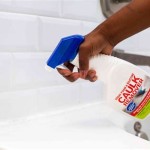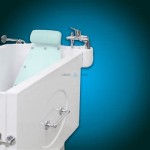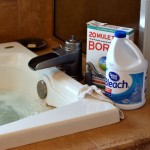Spray Painting a Fiberglass Bathtub: A Comprehensive Guide
Fiberglass bathtubs offer a cost-effective and lightweight alternative to cast iron or steel tubs. However, over time, the gel coat finish on a fiberglass bathtub can become dull, scratched, or discolored. Instead of replacing the entire bathtub, spray painting provides a viable option for restoring its appearance. This article will detail the necessary steps, materials, and precautions for successfully spray painting a fiberglass bathtub, ensuring a durable and aesthetically pleasing result.
Surface Preparation: The Foundation for a Lasting Finish
Proper surface preparation is paramount to achieving a long-lasting and professional-looking finish when spray painting a fiberglass bathtub. Any imperfections, existing coatings, or contaminants left on the surface will negatively impact the adhesion of the new paint, leading to premature chipping, peeling, or blistering.
Cleaning and Degreasing: The initial step involves thoroughly cleaning the bathtub to remove any soap scum, mineral deposits, dirt, oils, or other contaminants. Abrasive cleaners containing chlorine bleach should be avoided as they can damage the fiberglass surface and interfere with subsequent paint adhesion. Instead, use a non-abrasive cleaner specifically designed for fiberglass or a mild solution of dish soap and water. Scrub the entire surface with a sponge or soft-bristled brush, paying particular attention to areas with stubborn stains or buildup. Rinse thoroughly with clean water to remove all traces of the cleaning solution. After rinsing, thoroughly dry the bathtub using a clean, lint-free cloth.
Repairing Damage: Inspect the bathtub for any chips, cracks, or scratches. These imperfections must be repaired before painting to ensure a smooth and uniform surface. Small chips and scratches can be filled with a fiberglass repair kit, available at most hardware stores. Follow the manufacturer's instructions carefully when using the repair kit. Typically, this involves cleaning the damaged area, applying the filler compound, allowing it to cure completely, and then sanding it smooth to match the surrounding surface. For larger cracks or more significant damage, professional fiberglass repair may be necessary. Ignoring these imperfections will result in the paint highlighting them, diminishing the overall appearance of the finished product.
Sanding: Sanding the surface of the fiberglass bathtub is crucial for creating a mechanical key for the new paint to adhere to. Use a fine-grit sandpaper (e.g., 320-grit or 400-grit) and lightly sand the entire surface. The goal is not to remove the existing gel coat, but rather to create a slightly roughened texture. Avoid applying excessive pressure, as this can gouge or damage the fiberglass. After sanding, thoroughly remove all sanding dust with a tack cloth or a damp cloth, ensuring the surface is clean and dust-free.
Etching (Optional): In some cases, etching the fiberglass surface may further improve paint adhesion. Etching involves applying a mild acidic solution to the surface to create microscopic pores. This provides a better bonding surface for the primer and paint. However, etching should be performed with caution, as over-etching can damage the fiberglass. Always follow the manufacturer's instructions for the etching product. Ensure adequate ventilation and wear appropriate personal protective equipment (PPE), such as gloves and eye protection, when working with etching solutions. After etching, thoroughly rinse the bathtub with clean water and allow it to dry completely.
Material Selection: Choosing the Right Products for Durability
The selection of appropriate materials is critical to achieving a durable and long-lasting finish when spray painting a fiberglass bathtub. Using the wrong type of paint or primer can result in poor adhesion, premature failure, and discoloration. Careful consideration should be given to the specific characteristics of each product to ensure compatibility with fiberglass and resistance to the harsh conditions of a bathroom environment.
Primer: A high-quality epoxy primer specifically designed for fiberglass is essential. The primer serves as a bonding agent between the existing gel coat and the new paint. It also helps to seal the surface, prevent moisture absorption, and provide a uniform base for the topcoat. Choose a primer that is compatible with the type of paint that will be used for the topcoat. Apply the primer in thin, even coats, following the manufacturer's instructions. Allow the primer to dry completely before proceeding to the next step. Sanding the primer lightly with fine-grit sandpaper (e.g., 400-grit) can further improve the adhesion of the topcoat.
Paint: Two-part epoxy paints are generally considered the best option for spray painting fiberglass bathtubs. These paints offer excellent durability, chemical resistance, and water resistance, making them ideal for the harsh conditions of a bathroom. They are also resistant to chipping, scratching, and fading. Single-part acrylic urethane paints can also be used, but they may not be as durable as two-part epoxies. When selecting a paint, choose a product that is specifically formulated for use on fiberglass and that is resistant to mold and mildew. Available in various colors and finishes, the choice should reflect the desired aesthetic outcome.
Spray Equipment: An HVLP (High Volume Low Pressure) spray gun is recommended for achieving a smooth and even finish. HVLP spray guns atomize the paint using a high volume of air at low pressure, resulting in less overspray and a more controlled application. Alternatively, aerosol spray cans specifically designed for refinishing bathtubs can be used. However, these cans may not provide the same level of control and uniformity as an HVLP spray gun. Always follow the manufacturer's instructions for the spray equipment, including proper settings and maintenance.
Safety Equipment: Adequate safety equipment is essential when spray painting any surface, particularly in an enclosed space like a bathroom. A respirator mask that filters out paint fumes is crucial to protect the respiratory system. Wear safety glasses or goggles to protect the eyes from paint splatter. Gloves should be worn to protect the skin from paint and solvents. Ensure adequate ventilation in the work area to minimize exposure to harmful fumes. Open windows and doors, and use a fan to circulate air. Consider using a spray booth to contain overspray and further improve ventilation.
Application Techniques: Achieving a Smooth and Durable Finish
The application technique plays a crucial role in achieving a smooth, durable, and professional-looking finish when spray painting a fiberglass bathtub. Proper technique minimizes runs, drips, orange peel, and other imperfections that can detract from the overall appearance of the refinished bathtub.
Masking: Thorough masking is essential to protect surrounding surfaces from overspray. Use painter's tape and plastic sheeting to cover all areas that will not be painted, including walls, floors, fixtures, and trim. Pay particular attention to areas where the bathtub meets the wall or floor. Overlap the tape and plastic sheeting to ensure complete coverage. Press the tape firmly against the surface to create a tight seal and prevent paint from seeping underneath. Remove any loose or peeling tape to prevent it from contaminating the paint job.
Spraying Technique: Hold the spray gun or aerosol can approximately 8-12 inches from the surface of the bathtub. Maintain a consistent distance and angle throughout the spraying process. Use a smooth, even motion, overlapping each pass by approximately 50%. Avoid arching the wrist, as this can result in uneven coverage. Apply thin, even coats of paint, allowing each coat to dry completely before applying the next. Multiple thin coats are preferable to one thick coat, as they are less likely to run or drip. Avoid spraying in windy or dusty conditions, as this can contaminate the paint job. If using an HVLP spray gun, adjust the settings to achieve the desired spray pattern and flow rate. Practice on a piece of cardboard or scrap material before spraying the bathtub to familiarize yourself with the equipment and technique.
Curing Time: Allow ample time for the paint to cure completely before using the bathtub. The curing time will vary depending on the type of paint used and the environmental conditions. Follow the manufacturer's instructions for the recommended curing time. Avoid exposing the freshly painted surface to water or harsh chemicals during the curing period. Protect the bathtub from dust, dirt, and other contaminants. Once the paint is fully cured, carefully remove the masking tape and plastic sheeting. Inspect the surface for any imperfections or touch-ups. If necessary, lightly sand any imperfections with fine-grit sandpaper and apply a thin coat of paint to the affected area.
Ventilation: Proper ventilation is crucial during the painting and curing process. Ensure adequate airflow in the work area to remove paint fumes and promote drying. Open windows and doors, and use a fan to circulate air. Consider using an exhaust fan to remove fumes from the room. Avoid breathing paint fumes. Wear a respirator mask that filters out paint fumes. If you experience any symptoms of overexposure, such as dizziness, headache, or nausea, immediately leave the work area and seek fresh air.
By meticulously adhering to these steps, selecting appropriate materials, and employing proper application techniques, it is possible to successfully spray paint a fiberglass bathtub, effectively extending its lifespan and enhancing its aesthetic appeal without the expense of complete replacement.

To Spray Or Not A Bathtub That Is The Caldwell Project

How To Paint A Bathtub Yourself The Nifty Nester

Diy Painted Bathtub Follow Up Your Questions Answered Addicted 2 Decorating

How To Paint Your Bathtub Yes Seriously Love Renovations

To Spray Or Not A Bathtub That Is The Caldwell Project

How To Paint A Tub With Rustoleum What Not Do

Painting A Fiberglass Bathtub What You Need To Know Hometalk

How To Paint Your Bathtub Yes Seriously Love Renovations

To Spray Or Not A Bathtub That Is The Caldwell Project

The Best Way To Spray Paint A Faucet Average But Inspired








